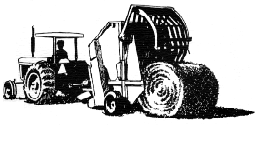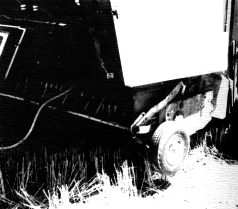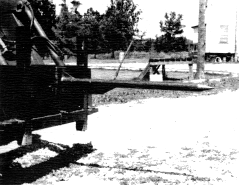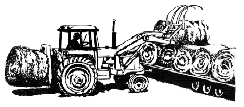 Introduction
Introduction
Much
of Ontario's hay crop is now harvested as large bales. Adoption
of big package haying systems has been very rapid, largely
because of the major labour savings it provides.
Along with the big bale benefits have come a number of hazards. The equipment used for large bale formation and handling harbours familiar dangers that are associated with all farm machinery. Round balers do feature some unique hazards, and the horsepower involved is usually greater than was required with more traditional, small, square baling systems.
However, the biggest risk -- and the one responsible for most of the serious injuries and deaths - is the physical nature of the balers themselves. A compact package of hay or straw weighing from 500 pounds to 1.5 tons (225 kg - 1300 kg) definitely poses some threat to human life and limb at every stage of handling! And because some bales are round, they can roll relatively freely and will gain momentum if the path of travel is downhill.
Equipment manuals should be part of every farm's safety program.
Following is a checklist of procedures which can help detect potential hazards and improve the efficiency of your baler:
Walk around the equipment before starting. Check that the rear gate is securely closed. Make sure there is no one in the vicinity. Let others know you are starting up, and don't do so until everyone is clear of the danger area.
Remember - this is a one-person operation! Never allow anyone to ride with you on either the tractor or the baler.
Preparing to baleThe pickup should be adjusted to provide adequate ground clearance. If tines contact the ground, the operator could be showered with earth and stones, and the baler won't feed properly. Engage PTO while the equipment is stationary and look and listen for any signs of trouble. Cycle all baler hydraulic systems to assure proper functioning. Check twine feeding and cutting mechanism for proper operation.
Obviously, the material to be harvested must be in suitable condition for baling (20 percent moisture or less). Excessive plugging is likely if the crop is wet.
Ground speed should be matched to crop conditions and windrow size. Keep the pickup high enough to aggressively deliver crop into the baler inlet. If the machine is equipped with feed rolls, maintain recommended clearance and pressure setting. Operator's manuals provide information on correct adjustments, operating procedures for various crops and conditions, etc.
Never try to unplug, clean out or adjust a baler while it is operating. Severe injury or death could be the result. Wait until all machine motion has stopped before approaching the baler.
Don't try to feed material into a machine by hand - the hay will be taken in faster than you can let go!
Refer to the operator's manual for bale tying instructions. Resist the temptation to produce oversized bales, which can make bale discharge difficult or damage components.
Safe ejectionIf it is necessary to open the tailgate for manual bale removal or unplugging, shift the tractor to neutral or park, lock the brakes, and disengage the PTO. Raise the tailgate hydraulically, lock it in place, then shut off the tractor engine and remove the ignition key.
Fire precautions
A well maintained baler will minimize breakdowns.
Large bale handling hazardsA number of operators have been seriously injured when improperly secured bales rolled down the arms of front-end tractor loaders. It is strongly recommended that tractors used to handle the big bales be equipped with 4-post rollover protective structures (ROPS), if available for your model of tractor.

Front end loaders must be equipped with proper restraining devices for handling large bales, such as this spear.
However, we shouldn't be relying on ROPS to cushion the blow, and bales shouldn't be moving down loader arms to begin with! A loader should be equipped with a spear or grapple that is specifically designed for handling the size of a large bale that is being produced on-farm. Most importantly, the loader should incorporate a restraining device that will prevent a bale that has come loose from sliding backward.
The loader tractor must be large enough and equipped with sufficient counterweight to handle bales safely. Set wheels at maximum width to increase stability.
Try to avoid steep slopes and rough terrain when conveying bales with the loader. If it is impossible to avoid sloping land, approach bales from the downhill side.
As with any loader operation, avoid sudden starts, stops or changes of direction. Always keep the bale as low as possible for maximum stability. A one ton bale puts the centre of gravity at a precarious level when a loader is raised high. The risk of a bale breaking free is also greater when the loader is raised. Be extremely cautious, and travel only at low speed.
Insist that other workers and bystanders stay well clear of bale handling operations.
Use good judgement when stacking bales in storage. High stacks mean more efficient use of available space, but subsequent removal could be very hazardous.
If bales are to be handled with a 3-point hitch attachment, the tractor must have sufficient front counterweight for stability and safe handling. Practice extreme caution when backing up to a bale. Keep everyone away from the bale and the forks.
Transport considerationsSuch purpose-designed equipment is safer for transporting round bales. However, we recognize that many farmers will continue to load their big bales on flatbed wagons that were originally built for conventional square bales. If the majority of a farm's harvest is likely to be in the form of large round bales, the owner should consider replacing at least one flat rack with a platform designed to carry round bales. Make sure that the round bale platform won't encourage the building of loads that exceed capacity of the running gear.
It is very important for large bales to be well secured on a flat rack. They should be tied down if the load is to be transported on a public roadway. An innocent bystander was killed by round bales that jolted loose from a flat rack at the top of a hill on a township road.
Following are some additional pointers for transporting loads of large round bales:

Front end loaders must be equipped with proper restraining devices for handling large bales. Counterweights on the tractor may help prevent tipping.
SummaryPlease keep the following points in mind when working with large bales:
Publication #: F-019
The information and recommendations contained in this publication are believed to be reliable and representative of contemporary expert opinion on the subject material. The Farm Safety Association does not guarantee absolute accuracy or sufficiency of subject material, nor can it accept responsibility for health and safety recommendations that may have been omitted due to particular and exceptional conditions and circumstances.
Farm Safety Association Home Page
Disclaimer and Reproduction Information: Information in NASD does not represent NIOSH policy. Information included in NASD appears by permission of the author and/or copyright holder. More